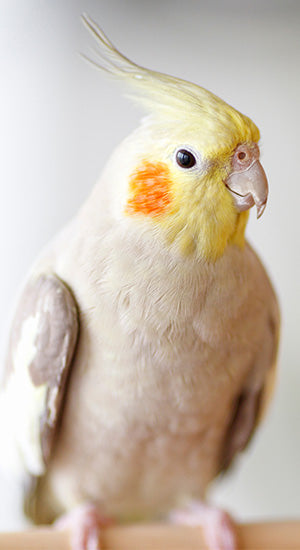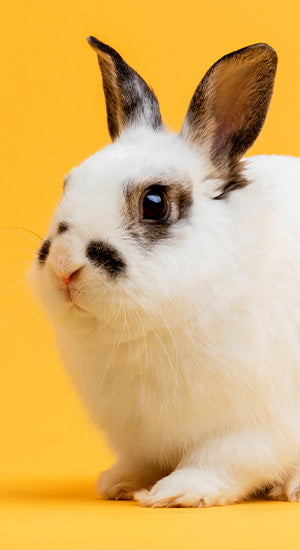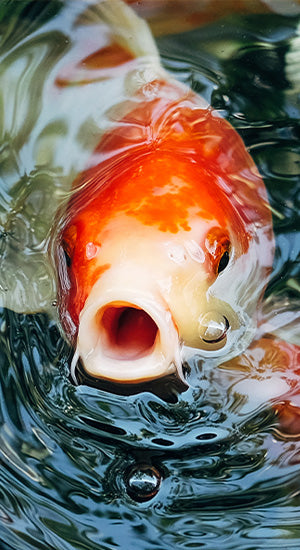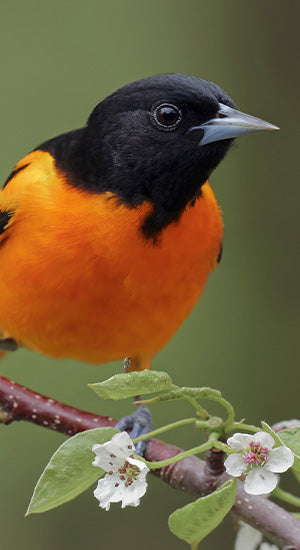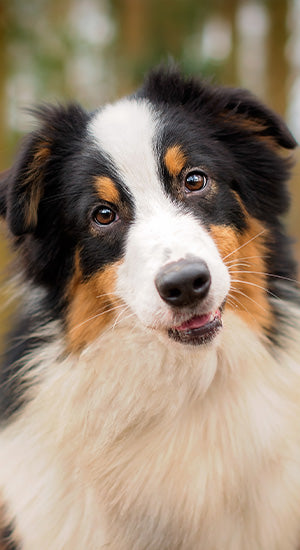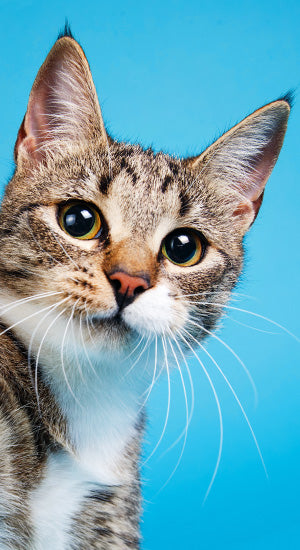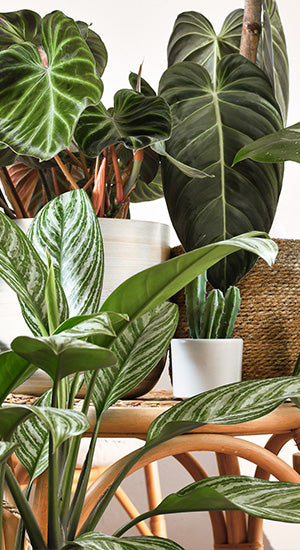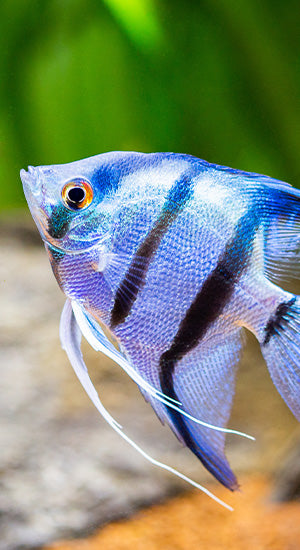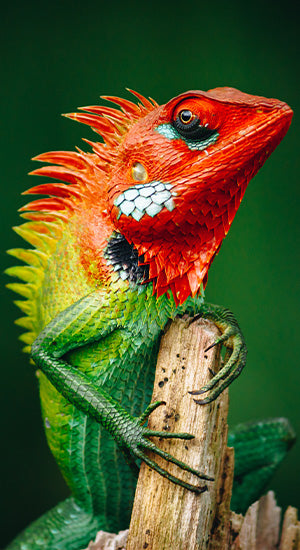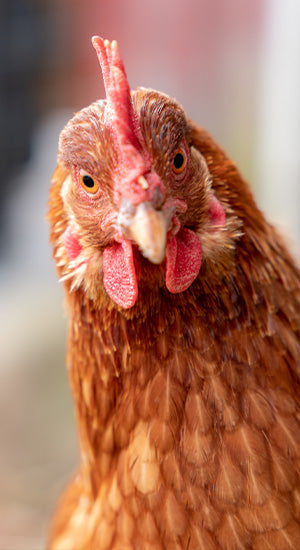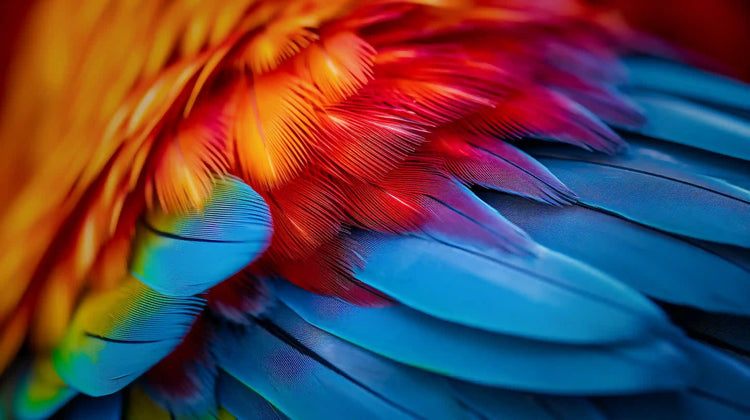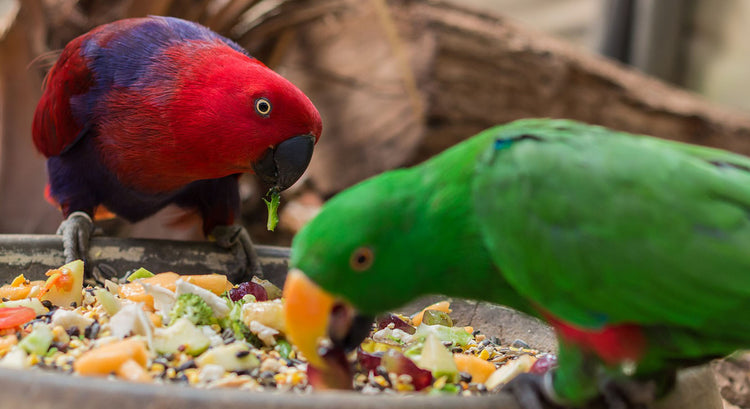
Why Are Seeds Considered Unhealthy?
Seeds that are in our pet bird’s food are different from the seeds that occur naturally. The seeds in bird food come from plants that have been selectively bred and genetically modified for the highest yield and best taste. They are high in fat but that’s about it. They lack adequate amounts of other nutrients like amino acids, vitamins, and minerals. Birds kept as pets are significantly less active than birds in the wild, and so if a bird eats enough seeds that it gets adequate amounts of nutrients it will almost surely result in other complications due to the volume of fat and oil that was also consumed. It is very important that birds on a seed diet are being supplemented with a vitamin powder that coats the seed. There is no one seed that has every essential amino acid. To check if your seed has amino acids, look for “VAM” written on the bag. This stands for Vitamins, Amino Acids and Minerals. Seed is not a complete diet on its own, and will not suffice long term. This is because even with the added “VAM”, the bird will often have to eat an incredibly large amount of seed to fulfil its body’s needs. Since seeds tend to be high in fats and carbohydrates, eating such large amounts will often result in birds that are overweight and prone to liver diseases. Additionally, it must be considered that birds get full. Even “VAM” fortified seeds will not guarantee that a bird eats enough to satisfy its body's needs for life-giving vitamins, minerals, and proteins. It is required that birds be fed additional sources of nutrients. A healthy, long-term diet includes pellets, vegetables, seeds, fruits, and occasionally some form of protein, such as eggfood. Even birds on a balanced diet will benefit from vitamin supplements, some of which can be placed in the cage for the bird to use as needed (“beak blocks”).
Good Seed Vs. Bad Seed
Seeds can be divided into two groups; oilseeds and cereal seeds. As the name suggests, oilseeds are oilier, and because of this, their fat content is quite high.
Oilseeds include, but are not limited to:
- Striped Sunflower (~51% fats),
- Cashew Nuts (~47% fats),
- Nyjer (~30% fats), and
- Anise (~21% fats).
A fat content this high is very unhealthy for most bird species and therefore must be offered in moderation, if at all.
The second kind of seed, as mentioned earlier, are the cereal seeds. They are considerably lower in oil (and therefore fat) content, and are, in fact, a great source of carbohydrates.
Some examples of cereal seeds are:
- Oats (~7% fats),
- Canary Grass (~5% fats),
- Millets (~4% fats),
- Basmati Rice (<1% fats).
Much like humans, though, birds benefit from variety. Offering a small amount of seed as a treat occasionally is okay.
The type of bird being fed the seeds needs to be considered, as some birds simply just should not have certain types of seed. For example, Conures of the genus Pyrrhura and many other types of Parakeets do not do well eating sunflower seeds. Instead, try using a small amount of anise or nyjer. In general, a seed treat mix should be no more than 25% oil seeds, because of their high-fat content.
Storing Your Seed
Seeds naturally have a moisture content of about 5-13%, depending on how well they were dried. The birdseed we buy in stores often comes one of 2 ways; nitrogen-flushed bags or breathable bags. Seed that comes nitrogen-flushed is most bags that are completely sealed from the air. Upon opening these bags nitrogen is allowed back in. Sealing the bag at this point creates a humid, nitrogen-rich environment perfect for the growth of fungi and bacteria. The most common are fungi called Aspergillus (especially A. fumigatus). They cause an infection called aspergillosis, which can affect the entire respiratory system. A bird that already has health issues, or is on an all-seed diet, is at a greater risk of aspergillosis infection, and the more seed a bird eats the greater the chances of infection are.
The best ways to avoid an aspergillosis infection are to expose as much seed to the air as possible and keep your cages as clean as possible by vacuuming the area frequently, changing the paper under the grill daily (for dustier birds try giving the paper a light misting with water before removing it), and allowing some airflow so the air does not get stagnant and stale. For bags that “breathe”, it is still recommended to leave the bag open simply because there can never be too much airflow when it comes to storing seeds. A common way of storage is to purchase a small, low container and dump the seeds into that. It can be decided whether to drill holes in the lid or to simply not use the lid, the latter being the better of the two options, but not practical for all living situations.
Sprouting Your Own Seed
Seeds that have been sprouted are an extremely valuable item that should be added to a bird's diet. The seeds are at an all-time high for nutrients when the radicle is just about to break through the seed coat. However, this is kind of a hard stage to catch, and so feeding after the radicle has begun growing or even when the cotyledon(s) is present still has great nutritive benefits. Sprouting seeds is very easy to do, and can be a great way to get children involved with bird husbandry. The seeds should be thoroughly rinsed, soaked for 24 hours, then placed onto a damp surface and kept in a warm spot. Sprout time varies by the type of seed as well as the specific conditions. After being collected and before being fed the sprouts should be washed well to reduce the possible risk of bacteria and other unwanted things that may be present.
Good Nuts Vs. Bad Nuts
Nuts are very low in moisture, but this means the nutrient concentrations in them are very high. They make great treats but should not be fed in large amounts because they do tend to be rather fatty. Using nuts to increase a bird’s weight is one of the healthiest ways to do so, but should be done gradually and not rushed to avoid excessive amounts of fat in your bird's diet. Some nuts, such as almonds, are also excellent sources of calcium. Our pet birds, especially African grey parrots and birds that are laying eggs, benefit greatly from some almonds in their diet. Be careful not to overdo it, though, because as stated nuts are quite high in fat. Peanuts, which are actually a legume, grow in the ground. For this reason, they introduce the risk of a bacterial or fungal infection and should be avoided, especially in the shell.
Soy
Soy is used as a filler since it can be grown and harvested in massive amounts relatively inexpensively. Soy is very high in protein, which is why it’s a popular choice for pet food filler. However, soy protein is rather high in phytoestrogens (estrogen receptors). The amount of soy being used in the food, and the amount that birds will eat due to a high metabolism, results in a lot of estrogen receptors being consumed. This is not good for male nor female birds and can be the cause for moodiness or plucking. Additionally in female birds it can increase the chances of laying eggs, which opens the risk of becoming egg-bound. Thankfully some brands offer pellets that are soy-free. TOPs and Hagen Tropican Alternative are two examples of this.
What Are Pulses?
A pulse is a seed that is edible and grows in a pod. Pulses are an excellent source of fibre, protein, and a range of minerals. Chickpeas, for example, are packed with fibre, iron, magnesium, potassium, and vitamin B6 but are also low in fat and sodium, making them super valuable when added to your birds' fresh fruits and veggies. When cooking pulses it is important to remember not to add salt to the water, as they absorb water while cooking. Additionally, pulses can be sprouted, which provides a different balance of nutrients to your feathered friend. When sprouted, pulses are a primary source of the fat-soluble vitamins (A, D3, E, and K).
Rice
Rice is a popular way to add some carbs to a dish and is a staple in the diets of so many people worldwide. It is also a great way to add some carbs to a bird's diet. However, it must be taken into consideration that rice absorbs arsenic while growing. This is not really avoidable if you want to feed rice, but there are ways to work with it. Studies have concluded that brown rice and any rice grown in Texas has the highest arsenic concentration of all kinds of rice. Alternatively, Basmati rice from California tends to have the lowest amount of arsenic. Arsenic is a naturally occurring chemical that, in Europe, is considered a Category 1 Carcinogen. Needless to say, it is not something we want our birds consuming. Fortunately, some tests have shown that if you soak rice overnight, rinse it very well, and then cook it in a water to rice ratio of 5:1 the arsenic levels can be cut by as much as 82%. Similar to rice are quinoa and millet, which can both be cooked the same way and are low-arsenic. You can make rice an even better choice if you cook it in the water where vegetables were boiled since it will absorb some of the nutrient-rich water.
Pasta
Similar to rice, pasta is a great way to get some starches into the diets and can be especially useful for a bird that is underweight. Pasta should not be given in large amounts as it is very high in carbs and can cause a bird to become overweight. Also similar to rice, cooking pasta in the water where vegetables like carrots or sweet potato were boiled is a great way to get the nutrients left behind in the water into the bird.
Vitamins
Vitamins are used for many things in a bird's body. From maintaining good skin and feathers to preventing and fighting illness. It is very important that a bird eats a well-varied diet of pellets, vegetables, seeds, and fruit to ensure they are consuming plenty of vitamins. Vitamins are often divided into two categories; those that are water-soluble (BX and C) and those that are fat-soluble (A, D, E, and K). If your bird does not eat pellets it is recommended to use a vitamin and mineral supplement such as Hagen Prime to ensure your bird is getting the nutrients they need.
Vitamin A
Important for feather colour, as well as eye and immune system health. Vitamin A is the most common deficiency to see in pet birds. Common signs of vitamin A deficiency are weight loss, lethargy, respiratory and digestive complications (including an increased risk of infection), and diarrhoea. Birds with red or yellow colouring may appear paler if the diet is insufficient in vitamin A. Dark leafy greens and bright red/orange vegetables (sweet potato, bell pepper) are rich in beta-carotene, the primary source of vitamin A.
Vitamin B Complex
In general the B-complex is used for metabolism, stress relief, and some cellular functions. Birds should be given a B-complex supplement often, as the vitamin is not stored in the body, and any excess is excreted fast.
B1
Necessary for carbohydrate metabolism and maintenance of the central nervous system. Birds who have lost weight, have ruffled feathers, head tremors, and a lack of strength may be deficient in thiamine. Cereal grains are rich in vitamin B1.
B2
A vital part of the enzyme systems in the digestion and metabolism of food, as well as in cartilage and nerve-cell tissue growth. Many grasses are a source of riboflavin.
B3
Required for tissue integrity, cellular metabolic processes, and the nervous system. Birds that are deficient in niacin tend to have a loss in appetite, weakness, scaly feet, and diarrhea. B3 is found in sizable quantities in cereal seeds, quinoa, and acorn squash, however it is recommended to supplement with a powdered form.
B6
Fundamental for protein metabolism. Signs of deficiency are jerky movements. Cereal grains are an optimal source of pyridoxine.
B9
Used for the metabolism of proteins, and in cell division. Inadequate amounts will result in an anemic bird with immune system complications. Poor feathering is a common sign of deficiency, as well as fatigue or loss of appetite. Birds fed high protein diets, or large amounts of cabbage, oranges, and some beans and peas are at a higher risk of being deficient as these foods contain inhibitors. Leafy greens, broccoli, and some legumes are awesome sources of folic acid.
B12
Imperative for the health of nerves and blood cells, as well as the manufacturing of DNA. Signs of a bird that is lacking cobalamin would be fatigue, loss of appetite, or diarrhea. A deficiency in cobalamin may also cause a deficiency in folic acid. B12 is hard to source outside of animal material, but birds do a decent job at obtaining it through microbial synthesis. If a bird has received antibiotics it is advisable to use a supplement to ensure a sufficient intake is happening.
Vitamin C
Helpful for the construction and maintenance of cell walls, blood vessels, elastic fibres, and connective tissues. This vitamin is also an amazing antioxidant, and aids in the absorption of some minerals, such as iron. Most birds are actually able to manufacture ascorbic acid, using glucose and an enzyme in the liver. That said, birds which are suffering or have suffered liver disease should be offered dietary sources of vitamin C. Deficiency is very rare, but may result in lethargy and weakness. If necessary, ascorbic acid can be sourced from broccoli, bell peppers, oranges, or kale.
*It should be noted that fig parrots, lorikeets, and softbills will suffer liver damage if too much iron is absorbed, and therefore should NOT be fed a dietary source of vitamin C unless advised by an avian veterinarian.
Vitamin D3
Crucial in the absorption of calcium and the maintenance of strong, healthy bones and feathers. A bird’s body can make vitamin D using sunlight or full spectrum lighting. Since the windows in our homes are designed to filter out the sun’s rays, a bird will not get a sufficient amount of light to make vitamin D this way. For parrots, sunlight or supplementary light should not be given for longer than 2 hours per day. Finches, canaries, and sparrows require more vitamin D than parrots and parakeets, and can be allowed light up to 3 hours per day. Severe cases of deficiency will result in bowing of the limbs, and a surplus may result in calcification of soft tissues, and eventually hypertension and organ failure.
Vitamin E
An antioxidant combined with Selenium mostly used to hunt free radicals during fat metabolism. Vitamin E also protects vitamins A, B-complex, and C. Vitamin E is used in the health of cell walls and blood vessels. Vitamin E deficiency increases susceptibility to the parasite Giardia spp. A bird infected with this parasite may pass undigested, whole seeds in their droppings. A deficiency may also be associated with pancreatic or intestinal diseases. Green plant material is a valuable source of vitamin E.
Vitamin K
Plays an essential role in clotting mechanisms and protection against coccidiosis, an infection in the intestines caused by Coccidia parasites. Vitamin K is usually produced by bacteria in the gut, therefore deficiency is rare in most species. The consumption of some plants, such as sweet clovers, can increase the demand for clotting. Vitamin K also is used for the metabolism of calcium and phosphorus in bones, which would be affected by deficiency. A bird deficient in vitamin K will have internal and external hemorrhaging. If a bird has recently undergone antibacterial treatments it may struggle to synthesize enough of this vitamin. Dietary sources can be kale, broccoli, and brussel sprouts.
Choline
Especially important in young, growing birds and its requirements are based on the amount of B9 and B12 in the diet. A greater amount of protein or fat in the diet will result in the need for more choline. Birds deficient in choline will not properly metabolize fat, and suffer from fatty liver damage as well as the slipping of the Achilles tendon off the intertarsal joint groove. Choline can be sourced from plant materials like nuts, beans, and broccoli. However in the event of a deficiency, a concentrated dietary supplement should be used to minimize potential damage.
Minerals
Minerals, like vitamins, may not make up a huge part of the diet, but are a huge part of a bird's everyday life. Minerals are used for everything from growth and development, to the manufacturing and maintenance of bones and tissue, and also the transmission of sensory nerve pulses. It is very important that a bird gets enough of each mineral, which can be divided into the macro-minerals (Ca, P, Mg, K, Na, and Cl) which are required in larger quantities, and the micro-minerals, or trace-minerals(Fe, Zn, Cu, Mn, I, Se), which are only needed in “trace” amounts.
Calcium
Calcium used by the body exists as the ion Ca2+. If the calcium in the body is not in this form, a bird will be deficient despite having “adequate” amounts of calcium. Deficient birds may appear jumpy, and are subject to fits. Bowing of the limbs is also possible, as calcium is used to make and maintain strong bones. Severe cases will result in death. Ca2+ is controlled by vitamin D3, parathyroid hormone, and calcitonin. Calcium works in a ratio with phosphorus where as one increases, the other decreases. A ratio with about 1.5x more Ca than P is ideal. In the event your bird is laying eggs, 10x more Ca than P is ideal. Birds that only eat seed, are laying eggs, African Grey parrots, and those advised by an avian vet are birds that may require calcium supplementation using a concentrated product. Otherwise, a bird that is eating a well varied diet with pellets and lots of vegetables, should be acquiring the necessary amount of calcium. A calcium intake above 1% of the total diet is considered potentially dangerous. Calcium can be supplemented using a liquid form, powdered form, or cuttlebone.
Phosphorus
Phosphorus is used in the manufacturing and maintenance of strong bones, as well as the storage of energy as ATP (adenosine triphosphate), and in cell membranes. The amount of phosphorus in the bird’s body is regulated based on the amount of calcium in the body. If the phosphorus level exceeds the calcium level, it is possible that this will cause bone demineralisation and renal damage to the bird. Cereal seeds are high in phosphorus, but must be fed with an additional source of calcium to prevent nutritional secondary hyperparathyroidism.
Magnesium
Magnesium is mostly used in the bones of a bird's body, but is also needed for the phosphorus transfer when forming ATP. Magnesium also helps make the membranes of soft tissues, for example, the liver. It is mostly absorbed in the small intestine, and too much calcium will reduce the bird’s ability to absorb magnesium.
Potassium
Potassium is an extremely important mineral that the body uses as the ion K+. It is used for many intracellular activities. Namely these include membrane potentials, osmotic pressures, and acid-base reactions, such as the buffer reaction that maintains the blood's pH level. Deficiency is rare, but sometimes happens in situations of high stress. Deficiency can lead to heart problems, muscle spasms, and neurological dysfunction. Potassium is controlled by aldosterone in equilibrium with sodium. If deficiency occurs, bananas are a source that is often readily accepted.
Sodium
Sodium is the main extracellular ion used to regulate and maintain the acid-base balance and osmotic potential. It is used in the form Na+ with K+ for nerve signals and impulses. Deficiency is not common, but is possible after chronic diarrhoea or renal disease, because these disrupt the osmotic potential gradient of the kidneys and lead to dehydration. If the sodium level becomes greater than 1% of the total diet it is considered potentially deadly. Ideal sodium levels are around 0.1% of the total diet, and a bird on a pellet based diet should not receive additional sources of sodium unless advised by an avian veterinarian.
Chlorine
Chlorine is the major extracellular negative ion that exists as Cl-. It works to maintain acid-base balances with K+ and Na+. Dietary supplementation is not necessary as it is almost always found with sodium as NaCl, and excessive levels can cause severe complications to the bird. For this reason water that has added chlorine or chloride ions is not safe to use for birds.
Iron
Iron is used in erythrocytes to form the oxygen-binding centre of haemoglobin. Typically birds will not need to be supplemented, as the body recycles iron from old red blood cells very well. Some bird species, like mynahs, are particularly good at absorbing iron in the small intestine, though. This can especially become a problem in the presence of vitamin C, which converts Fe to Fe2+ ions, which are more readily absorbed. This can lead to the liver becoming fatally overfull with absorbed iron. For this reason it is recommended the bird species which do this be fed as little dietary iron as possible.
Zinc
Zinc is largely used for wound healing, tissue formation, and in a number of enzymes. Young birds fed too much cabbage, wheat bran, or beans are at risk of deficiency. This is due to the presence of phytates, which bind the zinc and prevent it from being absorbed. High dietary calcium can also decrease the bird’s ability to absorb zinc. Deficiency may cause poor feathering, slowed growth, enlarged intertarsal joints, and perosis.
Copper
Copper is used in synthesizing haemoglobin, collagen, and maintaining the nervous system. A bird which is weak, jumpy, or suffers limb deformities may be deficient. Copper can be found in some nuts, seeds, and leafy greens.
Manganese
Manganese is needed for normal bone structure. It is often found in plants, but is not normally usable this way. Proper bile salt production is needed for its absorption, so birds with hepatic and biliary problems are at risk of deficiency. Deficiencies often include flattening of the lateral condyles of the intertarsal joint resulting in perosis, also, the tibiotarsus and tarsometatarsus may become twisted.
Iodine
Iodine is used only for the manufacturing of thyroid hormone. Deficiencies result in goitre and have effects such as stunted growth and neurological issues. Budgies are especially at risk of deficiency and the enlarged thyroid gland will constrict their tracheal lumen, resulting in a hunched posture when perched. Budgies must have access to iodine either as a liquid supplement or an iodine block.
Selenium
Selenium functions similar to vitamin E, and both are found in the enzyme glutathione peroxidase. If a bird is deficient in both vitamin E and selenium, the bird will suffer from a case called ‘exudative diathesis’. A complication where the small, subcutaneous blood vessels are damaged and become leakier. Fluid moves out rapidly, causing oedema over the neck, wings, and breast. Often this results in weakness and death. Selenium content is very reliant on the amounts in the soil where the plant was growing. However, a bird eating a good pellet based diet should be receiving enough selenium.
Water
Water can be acquired in a few ways. The first is just drinking water, whether that be from a dish or a bottle. The second way is being absorbed from fresh fruits and vegetables. Cucumbers are 96% water and would be a great choice for longer car rides during the warmer months to keep the birds hydrated. Nuts and seeds are very low in water content, rarely exceeding 10%. The third way is through metabolic processes, some of which produce water. However, this third way does not produce enough to be significant, and so we will ignore it. Most bird species will readily drink from a water dish or bottle to get the majority of their necessary moisture content. However, some birds such as budgies and some finches will rarely drink water in its purest form. Instead, they rely heavily on the moisture content provided to them by fresh fruits and veggies. For the birds that do drink water, though, spring water or well water suitable for human consumption is ideal so long as there are no chlorine filters. Water provided municipally is almost always treated with chlorine, therefore, making it unsafe to give to birds. Distilled water removes all mineral content from the water, therefore making it an unhealthy choice long term as the birds can benefit from these extra minerals. Water must be provided fresh at least once daily, but more often if your bird tends to poop or make pellet-soup. Water given for drinking must not be given significantly hotter, or colder than room temperature, as this may shock the birds.

